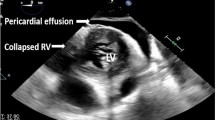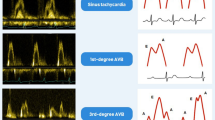Abstract
Background
Infective endocarditis carries a high morbidity and mortality; therefore, a rapid diagnosis and timely treatment is crucial to improve outcomes. Diagnosis of infective endocarditis is supported on echocardiogram findings.
Case presentation
An adult male with history of long-term hemodialysis, presented with embolic manifestations (cerebral, skin) and fever. A large vegetation in the mitral valve and other in the tricuspid valve were detected by point-of-care transthoracic echocardiogram, while blood cultures subsequently resulted positive for methicillin-resistant Staphylococcus aureus. Despite therapeutic efforts, the patient developed into an irreversible shock and died.
Conclusions
Point-of-care echocardiogram has a pivotal role in diagnosis and decision-making of infective endocarditis.
Similar content being viewed by others
Background
Infective endocarditis (IE) carries a high morbidity and mortality that are mostly related to heart failure and embolism. Therefore, reaching an early diagnosis is essential for guiding appropriate and timely interventions.
IE alludes to the infection of the endocardium. It typically involves the valves and/or perivalvular tissue but can also include the subvalvular apparatus, mural endocardium, ascending aorta, Eustachian valve or Chiari network, and electronic intracardiac devices (e.g., pacemaker leads). IE is broadly classified in native-valve endocarditis and prosthetic-valve endocarditis.
Here, we presented a case of an adult male with a typical case of native-valve endocarditis where point-of-care (POCUS) transthoracic echocardiogram (TTE) aided in establishing the diagnosis and prognosis. Then, we succinctly review the disease and the role of POCUS on diagnosis and decision-making.
Case presentation
A 43-year-old male was brought to the Emergency Department (ED) with a left-sided hemiparesis and mixed aphasia. He had a long-term history of end-stage renal failure on hemodialysis with difficult vascular accesses because of infection-related devices (two failed prosthetic arteriovenous grafts in the upper arms, loss of a cuffed catheter in the left subclavian vein and several losses of non-tunneled catheters). On presentation, vital signs were a heart rate of 110 beats/min., respiratory rate of 20 breaths/min., axillary temperature of 38 °C (100.4°F), blood pressure of 160/90 mmHg and pulse oxygen saturation of 96% breathing on room air. Glasgow Coma Scale was 12/15 (M: 5; E: 3; V: 4), with mixed aphasia and left-sided hemiparesis. Several petechiae were found in conjunctivae and in the hands and feet. The patient had a non-cuffed hemodialysis catheter placed in the right femoral vein that was used for renal replacement therapy. Relevant data on blood analysis were a hemoglobin level of 7 g/dL, platelet count of 16,000 per microliter, a prothrombin time of 18 s and a fibrinogen level of 130 mg/dL (overt disseminated intravascular coagulation). Two sets of blood cultures were taken at admission. Cranial computed tomography showed a right-sided parietal and occipital lobe infarcts. A point-of-care transthoracic echocardiogram (TTE) showed a non-dilated left ventricle with moderate impairment of the systolic function. A pedunculated oscillating mass measuring 22 mm × 13 mm was attached to the atrial side of the anterior leaflet of the mitral valve which triggered a severe mitral regurgitation (Fig. 1a and b and Additional file 1: Video S1 and Additional file 2: Video S2). Also, a fixed mass measuring 18 mm × 10 mm was observed attached to the atrial side of the posterior leaflet of the tricuspid valve; minor tricuspid regurgitation was noted (Fig. 1c and Additional file 3: Video S3). Aortic and pulmonary valve leaflets were thin, with no stenosis or regurgitation. Left ventricle filling pressure was elevated. Size and systolic function of the right ventricle were normal. Based on the whole clinical picture and POCUS-TTE findings, the diagnosis of infective endocarditis (IE) was first considered. He started on vancomycin and meropenem. Subsequently, methicillin-resistant Staphylococcus aureus grown in blood cultures and IE was therefore confirmed. Given the lack of cardiovascular surgery capabilities in the hospital and that the patient rapidly developed into an irreversible shock, he died shortly thereafter.
Point-of-care transthoracic echocardiogram showing signs of infective endocarditis. a Parasternal long axis (PLAX) view depicting a vegetation measuring 22 mm × 13 mm (calipers) attached to the atrial side of the anterior leaflet of the mitral valve. b PLAX showing a severe mitral regurgitation (arrows) triggered by the mitral valve vegetation. c Right ventricular inflow view showing a vegetation of 18 mm × 10 mm (calipers) in the atrial side of the posterior leaflet of the tricuspid valve. LV left ventricle, LA left atrium, AoR aortic root, AV aortic valve, MV mitral valve, da descending aorta, RVOT right ventricular outflow tract, RV right ventricle, RA right atrium, TV tricuspid valve
Discussion
The diagnosis of IE can be reached using validated criteria which are mainly based on blood culture results and echocardiographic findings, and several minor criteria [1,2,3]. Recently, 18F-fluorodeoxyglucose positron emission tomography/computed tomography (18F-FDG PET/CT) showed also a role in diagnosing prosthetic-valve endocarditis [4].
Vegetations (i. e., oscillating masses on the low-pressure side of valvular leaflets), perivalvular abscess (i.e., anechoic area in the perivalvular tissue, which if filled on color Doppler is indication of a pseudoaneurysm) and a new dehiscence of a prosthetic valve (typically detected as a pathologic perivalvular leak) are the tree main echocardiographic findings of IE [1]. Minor echocardiographic findings include valve fenestrations, nodular valve thickening and non-oscillating targets [3] (Table 1).
In general, sensitivity of TTE is lower for native-valve endocarditis compared to transesophageal echocardiogram (TEE). TTE has a sensitivity of about 75% for detection of vegetations in native-valve IE, which rises to around 90% for TEE [1]. Specificity is high for both methods (about 90%) [1]. For perivalvular abscess, the sensitivity of TTE is about 50%, reaching about 90% for TEE. Specificity is also similar for both methods (about 90%). For prosthetic-valve endocarditis and device-related IE, TEE has a better sensitivity compared to TTE. Despite the high sensitivity and specificity of TEE, around 15% of patients show false-negative echocardiograms. Therefore, TEE should be repeated in 7–10 days if the suspicion of IE remains high. As the first method to use, TTE is non-invasive, aids in detecting vegetations and also provides crucial information about the systolic and diastolic function of both ventricles as well as the repercussion of valvular regurgitation on the cardiac function (i.e., low cardiac output, high left ventricular filling pressure/pulmonary edema). Limitations of TTE are a poor acoustic window, detecting small-sized vegetations and prosthetic valve/device-related endocarditis. While the initial exam to be performed is TTE in all patients with suspicion of IE, TEE should be always subsequently performed in most cases (Fig. 2). For right-sided endocarditis, TTE is not inferior to TEE [1].
Diagnostic algorithm for echocardiographic diagnosis of infective endocarditis. TTE transthoracic echocardiogram, TEE transesophagic echocardiogram. Modified from [1]
Knowing the size of the vegetations aids in estimating the risk of embolism (> 10 mm high risk; > 15 mm very high risk) [1]. In general, vegetations in the mitral valve have a high risk of embolism, as observed in our patient, while IE of the aortic valve produce more often destructive lesions (abscess formation) [1]. The most important differential diagnosis of vegetations include tumors, thrombus, catheters/leads, papillary muscle or chordae tendineae rupture, prominent Eustachian valve and Chiari network, and also non-infective vegetations (marantic endocarditis) [1].
Surgery is typically indicated in native-valve endocarditis causing refractory pulmonary edema or shock, perivalvular abscess, large aortic or mitral vegetations (> 10 mm) following one or more embolic events, in prosthetic-valve endocarditis and in cardiac device-related IE.
Conclusions
IE is an entity with high morbidity and mortality. Early detection and timely treatment are pivotal, for which point-of-care echocardiogram (TTE at first instance, and then TEE) has a critical role.
Availability of data and materials
Not applicable.
References
Habib G, Badano L, Tribouilloy C, Vilacosta I, Zamorano JL, Galderisi M, Voigt JU, Sicari R, Cosyns B, Fox K, Aakhus S, European Association of Echocardiography (2010) Recommendations for the practice of echocardiography in infective endocarditis. Eur J Echocardiogr 11(2):202–219
Li JS, Sexton DJ, Mick N, Nettles R, Fowler VG Jr, Ryan T, Bashore T, Corey GR (2000) Proposed modifications to the Duke criteria for the diagnosis of infective endocarditis. Clin Infect Dis 30(4):633–638
Durack DT, Lukes AS, Bright DK (1994) New criteria for diagnosis of infective endocarditis: utilization of specific echocardiographic findings duke endocarditis service. Am J Med 96(3):200–209
Philip M, Tessonier L, Mancini J, Mainardi JL, Fernandez-Gerlinger MP, Lussato D, Attias D, Cammilleri S, Weinmann P, Hagege A, Arregle F, Martel H, Oliver L, Camoin L, Casalta AC, Casalta JP, Gouriet F, Riberi A, Lepidi H, Raoult D, Drancourt M, Habib G (2020) Comparison between ESC and duke criteria for the diagnosis of prosthetic valve infective endocarditis. JACC Cardiovasc Imaging 13(12):2605–2615
Acknowledgements
None.
Funding
The authors do not receive any funding.
Author information
Authors and Affiliations
Contributions
PB observed the case, performed the ultrasound examinations, collected the data, performed the literature review, drafted the manuscript, created the figures and edited the videos. LF and MFM contributed significantly to the drafting and editing of the manuscript. All authors read and approved the final manuscript.
Corresponding author
Ethics declarations
Ethics approval and consent to participate
All procedures performed in studies involving human participants were in accordance with the ethical standards of the institutional and/or national research committee and with the 1964 Helsinki Declaration and its later amendments or comparable ethical standards.
Consent for publication
Informed consent was obtained from relatives of the patient involved in the article.
Competing interests
The authors have no competing interests related to this submission.
Additional information
Publisher's Note
Springer Nature remains neutral with regard to jurisdictional claims in published maps and institutional affiliations.
Supplementary Information
Additional file 1: Video S1 Parasternal long axis (PLAX) view depicting a large vegetation attached to the atrial side of the anterior leaflet of the mitral valve.
Additional file 2: Video S2 PLAX showing a severe mitral regurgitation triggered by the vegetation.
Additional file 3: Video S3 Right ventricular inflow view (zoom view) showing a large vegetation in the atrial side of the posterior leaflet of the tricuspid valve.
Rights and permissions
Open Access This article is licensed under a Creative Commons Attribution 4.0 International License, which permits use, sharing, adaptation, distribution and reproduction in any medium or format, as long as you give appropriate credit to the original author(s) and the source, provide a link to the Creative Commons licence, and indicate if changes were made. The images or other third party material in this article are included in the article's Creative Commons licence, unless indicated otherwise in a credit line to the material. If material is not included in the article's Creative Commons licence and your intended use is not permitted by statutory regulation or exceeds the permitted use, you will need to obtain permission directly from the copyright holder. To view a copy of this licence, visit http://creativecommons.org/licenses/by/4.0/.
About this article
Cite this article
Blanco, P., Figueroa, L. & Menéndez, M.F. Native-valve endocarditis detected by point-of-care echocardiography. Ultrasound J 14, 42 (2022). https://doi.org/10.1186/s13089-022-00294-2
Received:
Accepted:
Published:
DOI: https://doi.org/10.1186/s13089-022-00294-2






